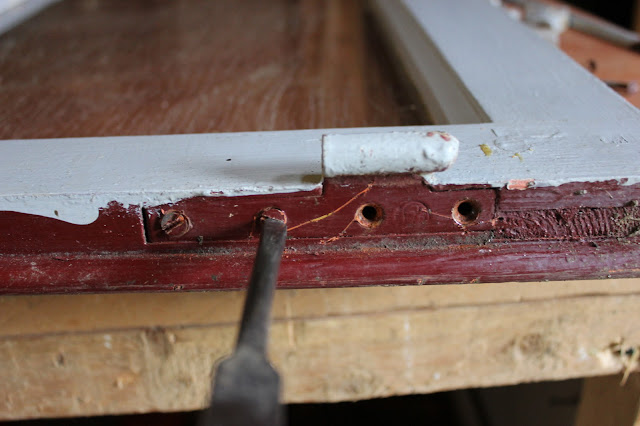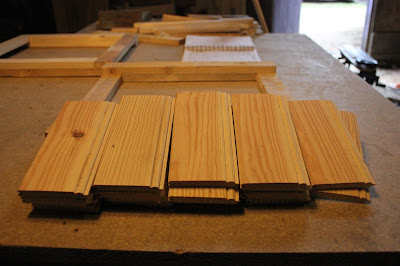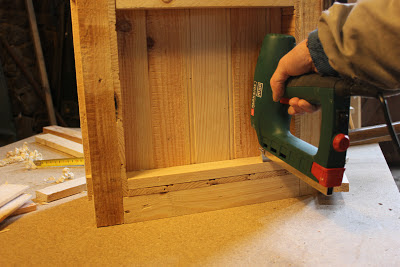I love this greenhouse because it seems so right in the surrounding rural scene and because it is made from such an interesting eclectic mix of recuperated materials including ships timbers, giant industrial packing cases and discarded pairs of French windows (here in France they are called 'door windows'). It also has multiple uses, providing water for the sheep and poultry from its roof, a reading room on a wet day for grandchildren, as well as the usual and expected year-round food production.
I also view it as a prototype for something we want to build, which is a sun space on our own tiny house.
Preamble
Eight years ago, when my neighbour, Bernard saw the recuperated-glass greenhouse I’d built, he wanted to follow suit and build his own. It took 7 years for him to ‘bite the bullet’ and finally fulfil his ambition. It was well worth the wait in this robust yet deceptively 'light' and 'airy' design.
Recuperated Materials
Before retiring, Bernard was an engineering technician and was involved in the installation of steam turbines at sites in Europe and the Middle East. He very prudently recuperated the wood from the crates used in transporting the turbines and brought it home to be stored in his shed. He also took some old ship timbers stored on his sister's farm before it was sold, these he used in the central roof support (see below).
 For the recuperated windows I took him to the joinery company from where I obtain all mine. The proprietor had already expressed his gratitude that someone (me) was taking his ‘rubbish’ and putting it to good use. Fortunately for Bernard on the day we went to see what was available, we found that the company had just completed a contract for replacing the windows in a large house. The result was that we filled Bernard’s trailer with 7 pairs of wood-framed double-glazed French windows.
For the recuperated windows I took him to the joinery company from where I obtain all mine. The proprietor had already expressed his gratitude that someone (me) was taking his ‘rubbish’ and putting it to good use. Fortunately for Bernard on the day we went to see what was available, we found that the company had just completed a contract for replacing the windows in a large house. The result was that we filled Bernard’s trailer with 7 pairs of wood-framed double-glazed French windows.
Some years’ ago there was a strip of land that ran alongside Bernard’s garden owned by a retired guy who grew vegetables on it. He sold this to Bernard when he moved away and on removing the fencing that separated the plots Bernard also removed the concrete foundation for this fence. These reinforced concrete beams were moved into his lower field for ‘safe keeping’. You can see them here, put to good use.
Construction
Bernard had erected a garage-sized ‘shed’ on his land in which he stored recuperated timber. The western elevation was chosen as the rear wall for the greenhouse. The garage/shed was steel-framed and clad in corrugated steel sheet. And had a single-pitch roof sloping to the western elevation.
The concrete beams were laid directly on the ground to form a ring beam and a mild steel angle iron was secured to it. Vertical wooden posts were secured to the garage wall from which the roof rafters could be attached and these in turn were attached to a wall plate supported by three uprights extending up from the ring beam.

Bernard fabricated his own joist hangers, to support the rafters, from scrap steel sheet. Additional support for the roof sheets was provided by noggins nailed between the rafters.

The windows were supported on the ring beam and were bolted to the upright face of the angle iron and to the wall plate at the top.
Provision was made for a door at each end of the greenhouse and once again suitable ones were obtained at our friendly joinery company.
The roof of the greenhouse was of clear, rigid plastic. Bernard was able to match the profile of the roof sheet to that of the metal roof cladding of the adjoining shed. Thus, by sliding the plastic sheet beneath the edge of the metal one, there was a weatherproof joint which would allow rainwater to run from the shed roof into guttering on the greenhouse roof perimeter.
As mentioned above, a gutter was fitted to collect the rainwater run off from the combined roofs (approximately 50 m²) and this was stored in a 1m³ food grade plastic container, thus providing adequate supply of water for irrigation in the greenhouse and as a bonus providing a clean water source for the animals grazing in the field.
In conclusion
After almost 2 years use, Bernard is really pleased with the increased yield from the prolonged growing season in the greenhouse and his only regret is he did not do it sooner. The cost for the roofing was obviously the biggest expenditure in this construction, but the resulting benefits of rainwater harvesting and structural integrity have proved it was a wise investment. The sheep and chickens are happy too!
I really like this project because it is a robust, weatherproof construction which could easily be adapted to provide a conservatory or draught lobby to a house.
It looks as if this is what we’ll be undertaking later this year in front of our tiny house in the garden. I’ll keep you posted!!
Now if you'd like to, sit back and watch the film.
Thanks for dropping by and feel free to, ask questions, comment and/or share this article. Hope to see you next time. Cheers, Andy
© Andy Colley 2014































































